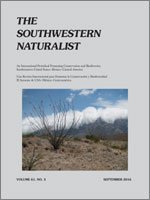We examined the indirect effects of reintroduced black-tailed prairie dogs (Cynomys ludovicianus) on resident kangaroo rat (Dipodomys) populations. We used the Giving-up Density theory to quantify kangaroo rat foraging on a black-tailed prairie dog colony vs. foraging near the colony edge or in the surrounding native habitat. This approach allowed us to assess the influence of black-tailed prairie dogs on kangaroo rat foraging activity. Our results showed a greater foraging preference off-colony in most seasons. Kangaroo rats visited off-colony feeding trays more frequently and collected a greater mean mass of seed as well. This indicated that kangaroo rats perceived the area off the prairie dog colony as having a lower foraging cost than the on-colony or colony edge locations. Our data suggest that from the perspective of the seed-eating kangaroo rat, the colony is not viewed as high quality habitat. Both prairie dogs and kangaroo rats have been described as keystone modifiers in grassland ecosystems. What impact the reintroduction and management of one keystone species might have on another keystone species deserves additional consideration as we attempt to restore arid grassland ecosystems.
How to translate text using browser tools
1 September 2016
Kangaroo rat foraging in proximity to a colony of reintroduced black-tailed prairie dogs
Kirsten M. Fulgham,
John L. Koprowski
ACCESS THE FULL ARTICLE

The Southwestern Naturalist
Vol. 61 • No. 3
September 2016
Vol. 61 • No. 3
September 2016




